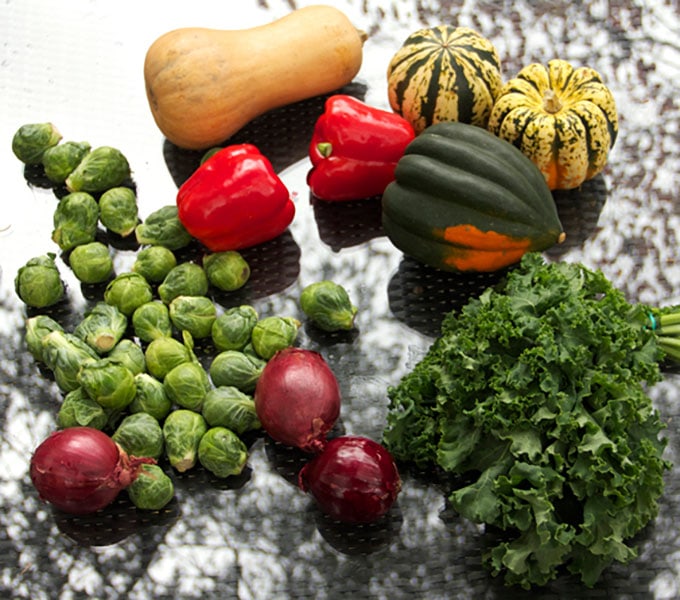One food that’s been gaining popularity among pet owners is butternut squash. But is this tasty vegetable safe for your dog? Dogs can eat butternut squash like other squashes such as courgettes or pumpkins. Butternut squash is one of the most nutritious and delicious fruits for dogs and it’s perfectly safe for them to eat regularly.
You can share squash with your dog depending on how it has been prepared. There’s nothing toxic about butternut squash for dogs; these super squashes are incredibly nutritious.
Can Dogs Eat Butternut Squash?
Yes, butternut squash is safe for dogs to eat when prepared correctly. It is a healthy addition to a dog’s diet because it contains fibre, vitamins, and minerals. It can help with digestion, hydration, and fur.
What’s in Butternut Squash?

Nutrients
Butternut squash is a nutritious winter vegetable that can be a healthy dog treat. It’s packed with fibre, vitamins, and antioxidants and can support your dog’s immune system, digestion, and skin and eye health. Here’s a breakdown of the benefits.
Additionally, butternut squash offers potassium, magnesium, and manganese—minerals that play crucial roles in muscle function, bone health, and overall cellular processes.
Health Benefits
Undoubtedly, butternut squash is one of the safest and healthiest fruits or veggies you could feed your puppy. It’s packed with vitamins and minerals that’ll help keep your fur-iend happy and healthy, and they usually go barking mad for the sweet, earthy flavour, too.
- Fiber Promotes healthy digestion, gut health, and regular bowel movements.
- Vitamins A and C Support the immune system, vision, joints, and healing.
- Potassium Benefits muscles, nerves, kidneys, and enzymes.
- Beta carotene The body converts this to vitamin A, which supports the immune system, eyes, and bones.
- Low in calories and fat: A healthy alternative to traditional treats
- Hydrates skin and Contributes to healthy fur.
Possible Risks
Butternut squash can cause dog digestion problems if it’s not cooked properly.
- Raw butternut squash is fibrous and hard, making it difficult for your dog to chew and digest. This can lead to stomach problems, vomiting, or diarrhoea.
- Big chunks of raw butternut squash can be a choking hazard and cause intestinal blockages.
- Butternut squash seeds can contain oils that upset a dog’s stomach.
- Butternut squash skin is difficult to digest, so it’s best to avoid it.
Should Dogs Eat Raw or Cooked Butternut Squash?

Raw Butternut Squash
Feeding your dog raw butternut squash can be a double-edged sword. On the one hand, it retains all of its natural nutrients, including high levels of fibre, vitamins, and minerals. This can be particularly beneficial for dogs needing extra dietary fibre.
However, raw butternut squash is tough and can be difficult for dogs to chew and digest, leading to potential choking hazards or digestive discomfort. While some dogs might handle it well, others could struggle with its fibrous texture.
Pros:
- Raw butternut squash retains all its nutrients, including fibre, vitamins, and minerals.
- The high fibre content can benefit dogs needing extra help with digestion.
Cons:
- Raw squash is harder to chew and digest, increasing the risk of choking. It can also be
- tough on a dog’s digestive system, potentially leading to gastrointestinal discomfort.
Cooked Butternut Squash
Cooked butternut squash is a safer and more palatable option for dogs. Cooking softens the squash, making it easier to chew and digest while enhancing its natural sweetness, which dogs enjoy. Although cooking can cause a slight reduction in certain heat-sensitive nutrients, the overall nutritional value remains high. This makes cooked butternut squash a great way to introduce this healthy vegetable into your dog’s diet without the risks associated with raw squash
Pros:
- Cooking butternut squash softens it, making it easier for dogs to chew and digest.
- Cooking also enhances its natural sweetness, which dogs tend to enjoy.
- Most nutrients remain intact after cooking, although some, like vitamin C, may diminish slightly.
Cons:
- Cooking can lead to slight losing nutrients, particularly heat-sensitive ones like vitamin C.
- the overall nutritional value remains high, making cooked butternut squash a safe and healthy option for most dogs.
Homemade vs. Store-Bought Butternut Squash Treats
1. Storebaught Butternut Squash
Store-bought butternut squash offers a convenient option for adding this nutritious vegetable to your dog’s diet. Pre-packaged and often pre-cooked, it saves you time in preparation. However, checking for added ingredients or preservatives that could harm your pet is important. Always opt for plain, unseasoned varieties to ensure your dog gets only the natural benefits.
2. Homemade Butternut Squash
A growing number of pet parents have bid farewell to store-bought pet treats and started making their companions’ snacks at home, and we at Fera Pet Organics are in full support of this budding trend. There are many great benefits to homemade pet treats you won’t find in a bag of commercial treats.
Here’s why we love homemade pet treats vs. store-bought and some fun and easy recipes that you can try at home today.
Why We Love Homemade Pet Treats

1. Quality Control
Homemade treats let you choose only the best, natural ingredients, ensuring your pet enjoys a healthy snack free from artificial additives and fillers.
2. Tailored to Dietary Needs
Customize treats to fit your pet’s unique dietary requirements, whether they need grain-free options or special protein sources.
3. Freshness Guaranteed
Enjoy the peace of mind that comes with knowing your pet’s treats are made from fresh, whole foods without the need for preservatives.
4. Cost-Effective
Save money by making treats at home, using ingredients you already have and buying in bulk for even more savings.
5. Bonding Experience
Turn treat-making into a fun, memory-filled activity that brings you closer to your furry friend, with them as the eager taste tester.
Homemade Treats
Pros:
- Making treats at home allows you to control the ingredients, ensuring no harmful additives or preservatives are included.
- You can customize the recipe to suit your dog’s specific needs, whether that’s avoiding allergens or adding extra nutrients.
- Homemade treats can also be more cost-effective in the long run.
Cons:
- Preparing homemade treats can be time-consuming, and if not done correctly, the treats might lack the proper balance of nutrients.
- There’s also the risk of introducing ingredients that could be harmful to your dog if you’re not careful.
Store-Bought Treats
Pros:
- Store-bought treats offer convenience and consistent quality. They’re often fortified with additional nutrients to ensure a balanced diet for your dog.
- These treats are usually designed to be tasty and appealing, making them an easy option for busy pet owners.
Cons:
- The downside of store-bought treats is that they may contain preservatives, artificial flavours, or other additives that aren’t ideal for your dog’s health.
- these treats can be more expensive, especially if you opt for high-quality, natural options.
Comparing Butternut Squash with Other Veggies for Dogs

Butternut squash vs Pumpkins
1. Nutritional Differences
Both butternut squash and pumpkin are rich in vitamins and fibre, but butternut squash has a slightly higher content of vitamins A and C. Pumpkin, on the other hand, is an excellent source of beta-carotene, which is converted to vitamin A in the body.
2. Digestibility
Both vegetables are easy for dogs to digest, especially when cooked. However, pumpkin is often recommended for dogs with digestive issues like diarrhoea or constipation, as it has a natural soothing effect on the digestive tract.
Butternut Squash vs. Sweet Potatoes
1. Nutritional Differences
Sweet potatoes are higher in carbohydrates and contain more calories than butternut squash. They’re also rich in beta-carotene and have a slightly higher fibre content. Butternut squash provides more vitamins A and C, making it a better choice for boosting the immune system.
2. Digestibility
Both sweet potatoes and butternut squash are easy to digest, but sweet potatoes are starchier, which might cause some digestive issues in sensitive dogs. Butternut squash is lighter on the stomach, making it a safer option for dogs prone to gastrointestinal problems.
How to Add Butternut Squash to Your Dog’s Diet
To add butternut squash to your dog’s diet, you can prepare it as a treat or use it as an ingredient in homemade dog treats. Here are some tips for preparing butternut squash for your dog
1. Wash
Wash the skin of the butternut squash to remove any germs.
2. Cook
Cook the butternut squash by steaming, boiling, baking, roasting, or microwaving. You can also saute it in a bit of coconut or olive oil. Avoid frying, which is less healthy.
3. Peel and seed
Remove the skin, guts, and seeds. Seeds can be a choking hazard.
4. Serve plain
Don’t add salt or seasonings, especially garlic or onion, which can be toxic to dogs.
5. Cool
Let the cooked butternut squash cool before serving.
6. Offer as a treat
You can offer chunks of squash as a treat.
What Do the Experts Say?
Veterinarian Advice
The veterinarians advise that butternut squash should be cooked before feeding it to your dog. Raw butternut squash is hard and fibrous, which can make it difficult for dogs to chew and digest. It can also cause stomach problems, vomiting, or diarrhoea.
Expert Tips.
Dog nutritionists often suggest incorporating butternut squash into homemade dog food recipes as a way to add variety and nutrients. Experienced pet owners recommend using butternut squash as a healthy alternative to commercial dog treats, especially for dogs that are on a weight management plan. The consensus is that butternut squash can be a beneficial part of a dog’s diet when prepared and served correctly.
Conclusion
Butternut squash is a nutritious and generally safe food for dogs when served in moderation. It’s packed with vitamins, minerals, and fibre that can benefit your dog’s overall health. However, it’s important to serve it cooked and plain to avoid potential risks like choking or digestive upset.

Overall, butternut squash can be a great addition to your dog’s diet, especially if you’re looking to add more fibre or nutrients. But as with any new food, it’s best to start small and consult your veterinarian if you have any concerns.
Before you introduce butternut squash or any new food to your dog’s diet, talk to your vet to ensure it’s the right choice for your pet. Have you tried feeding your dog butternut squash? Share your experience in the comments below!








